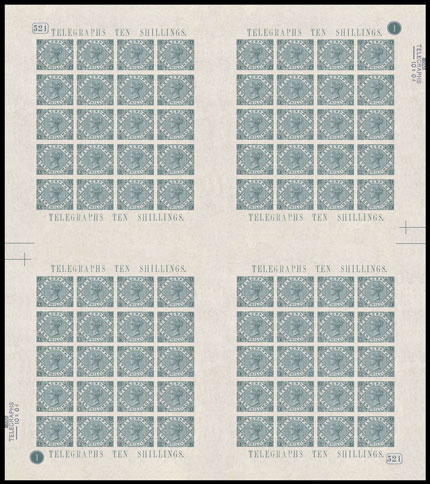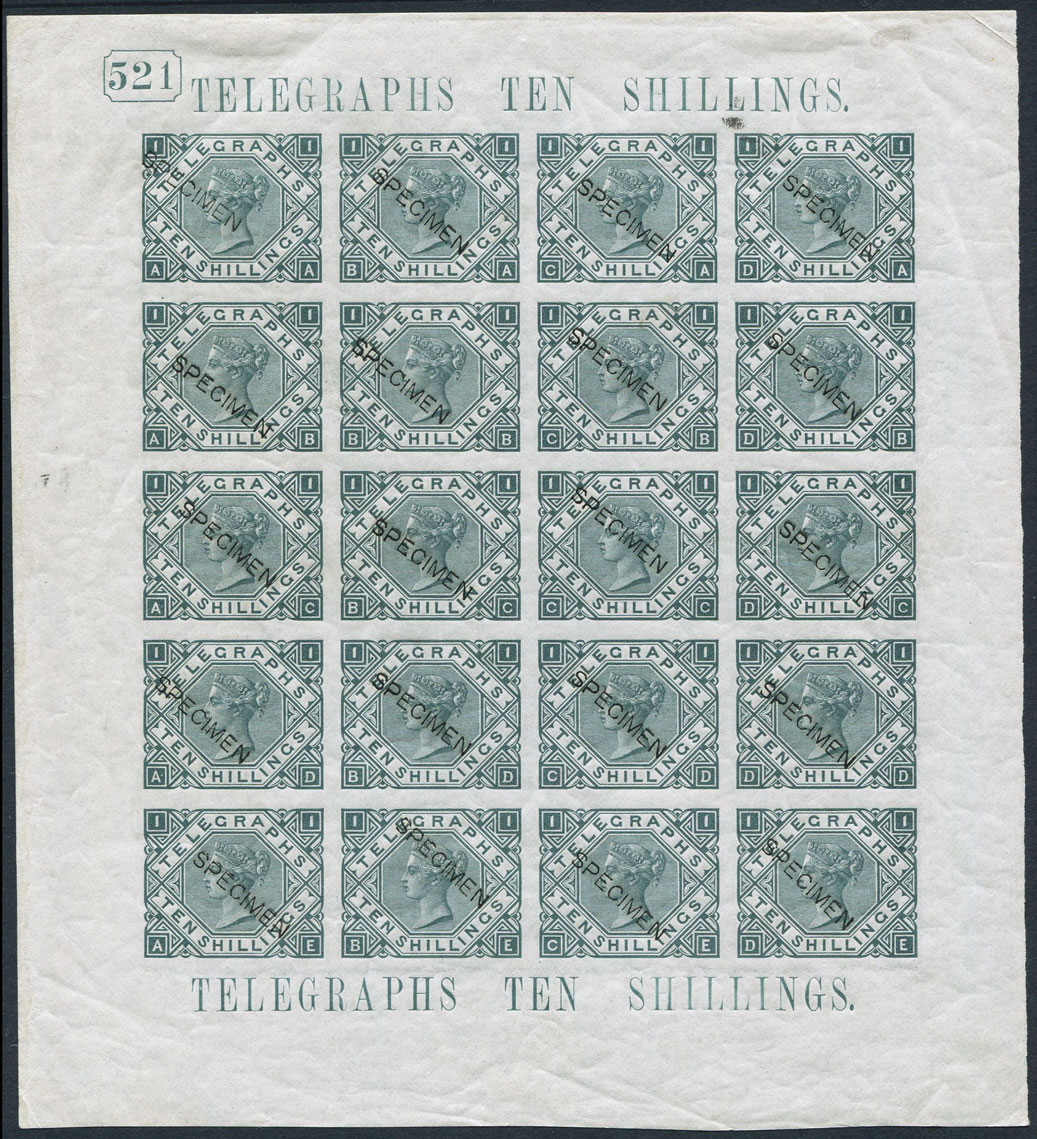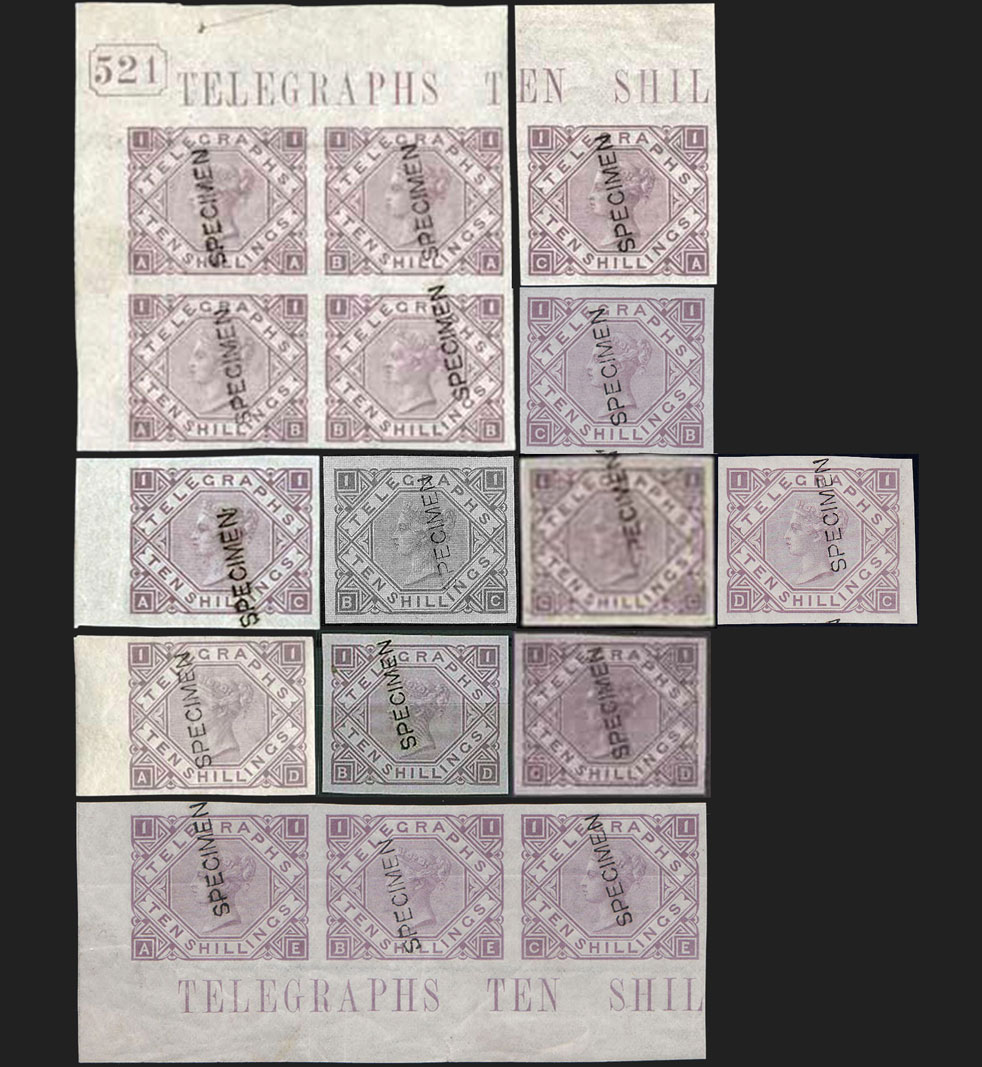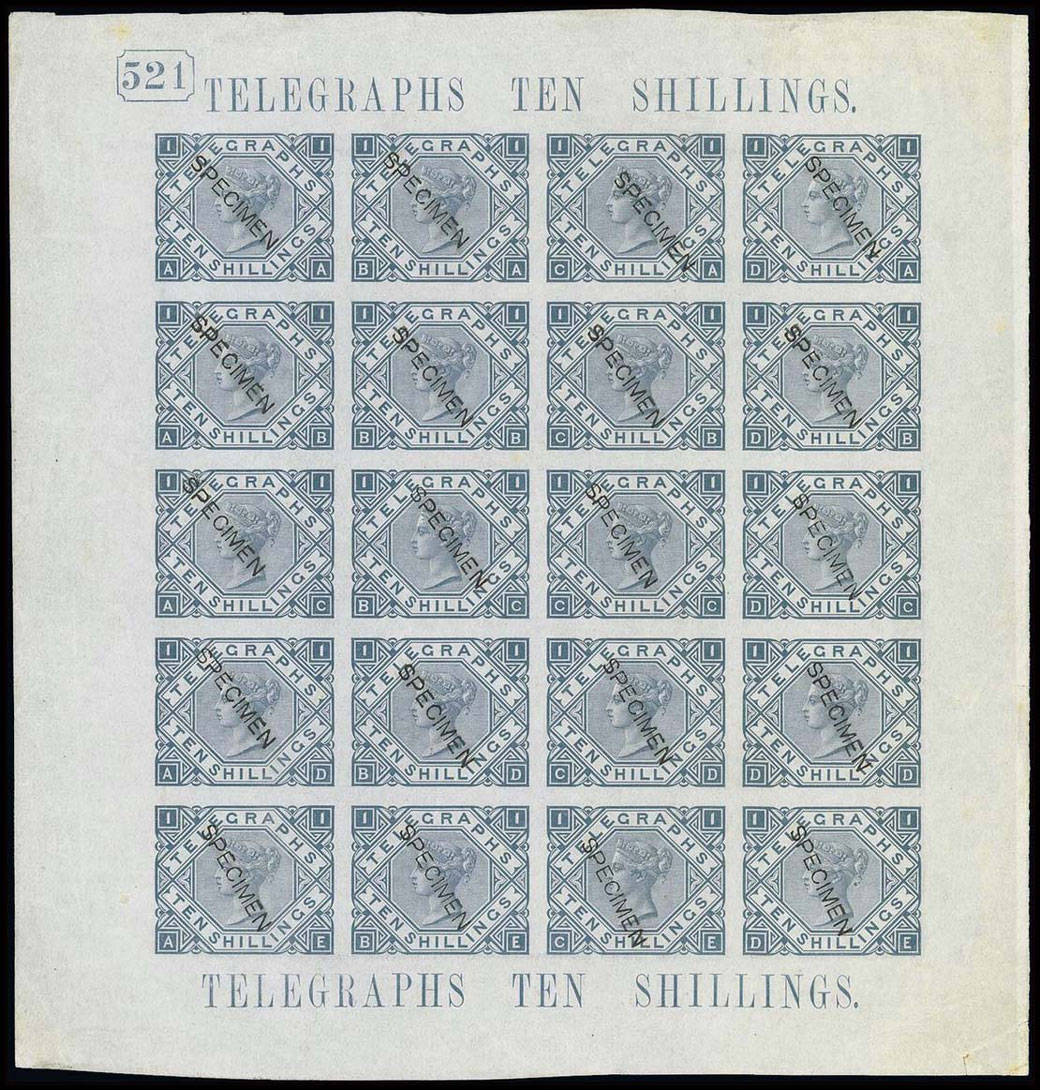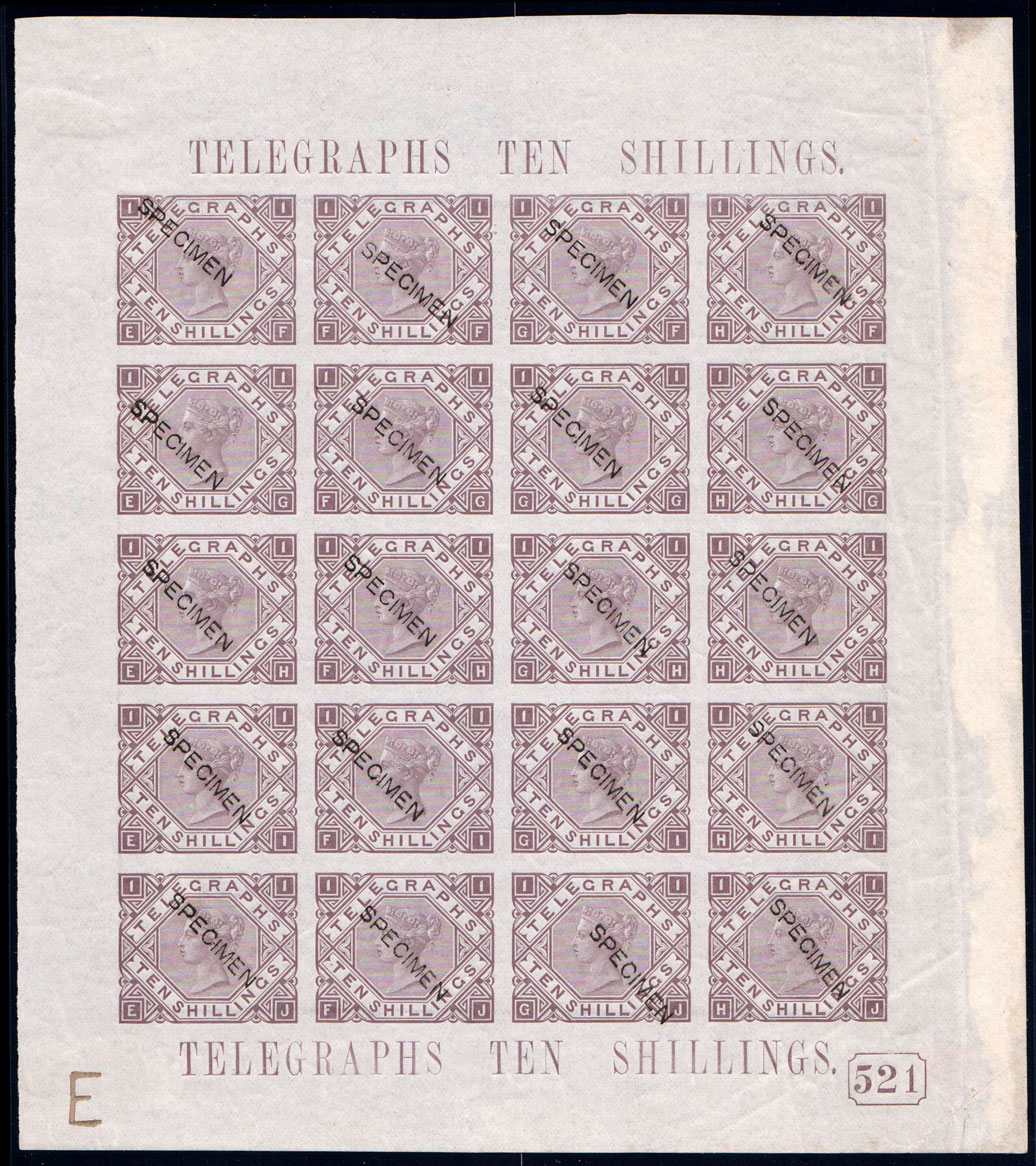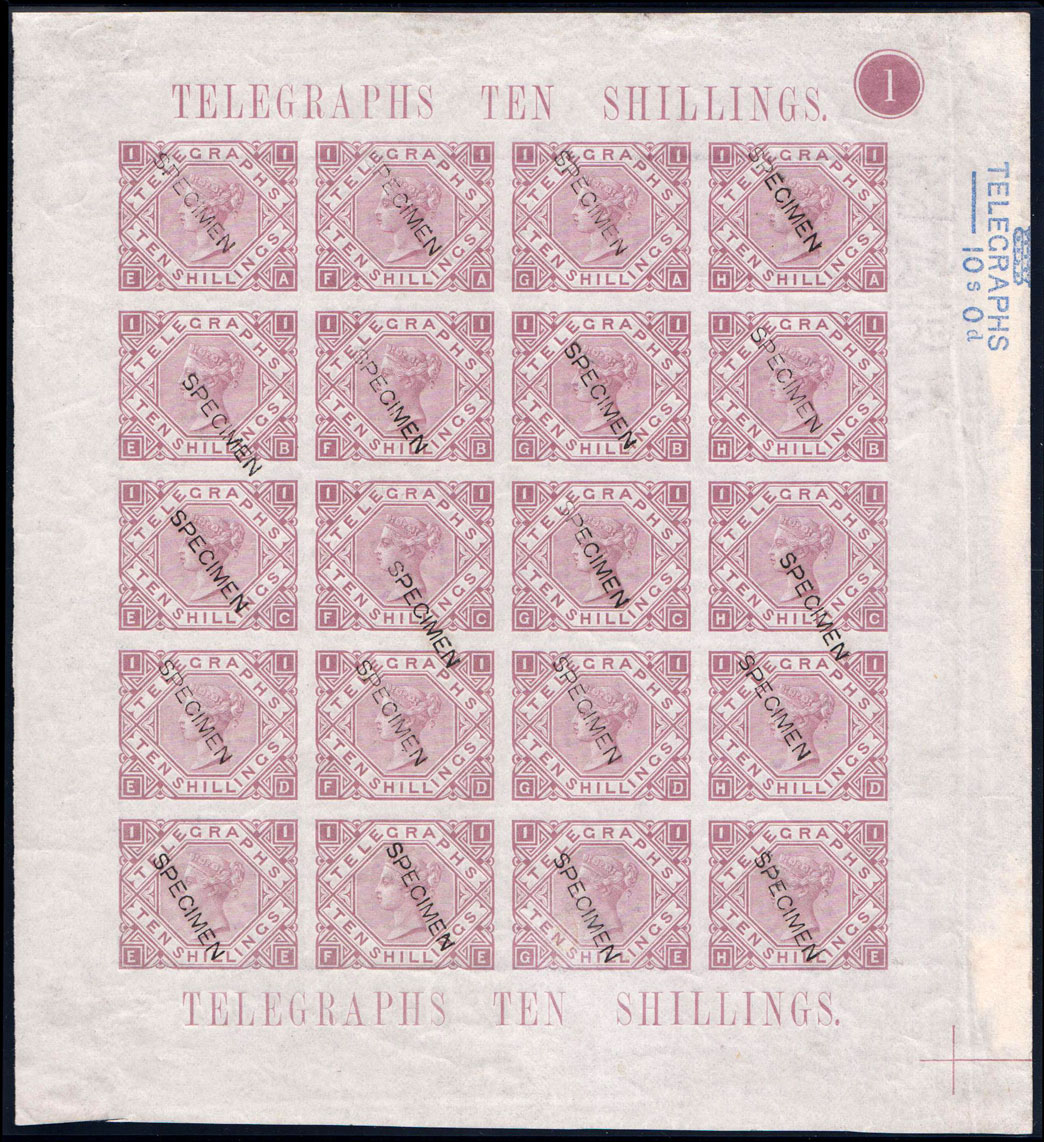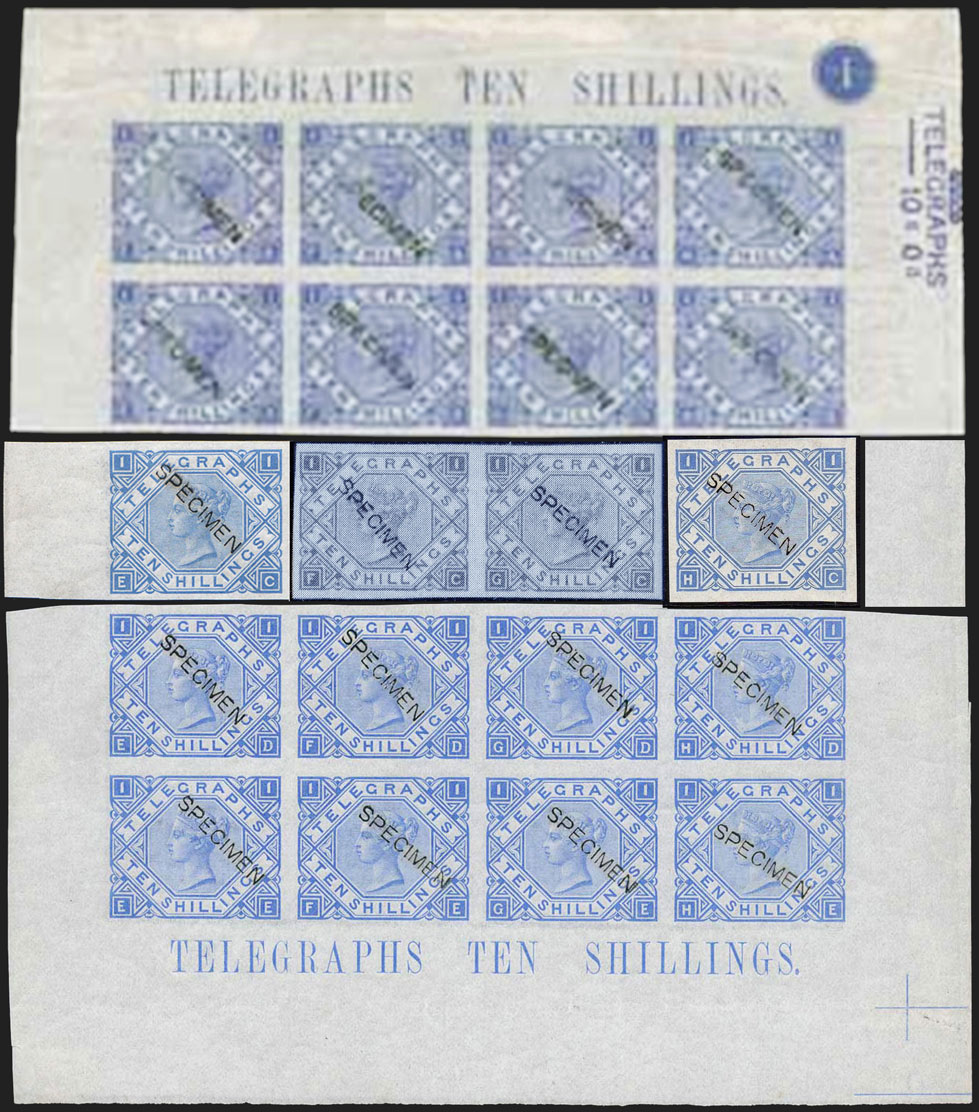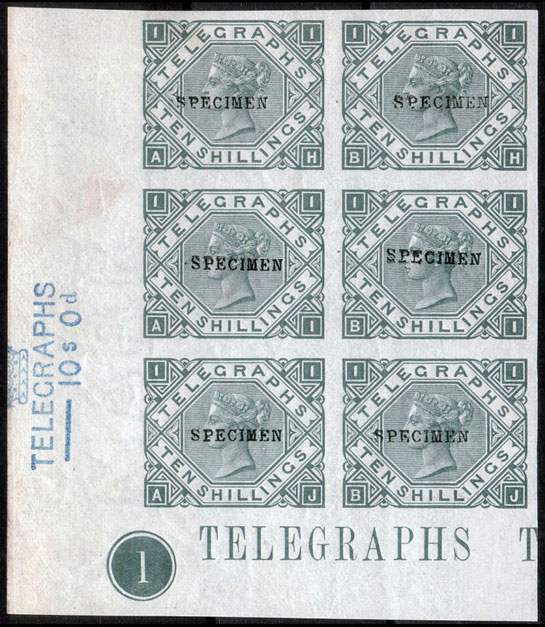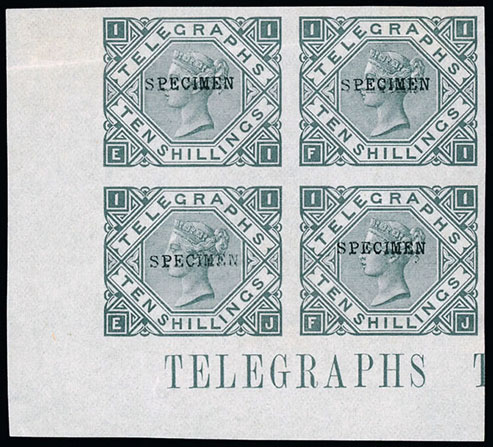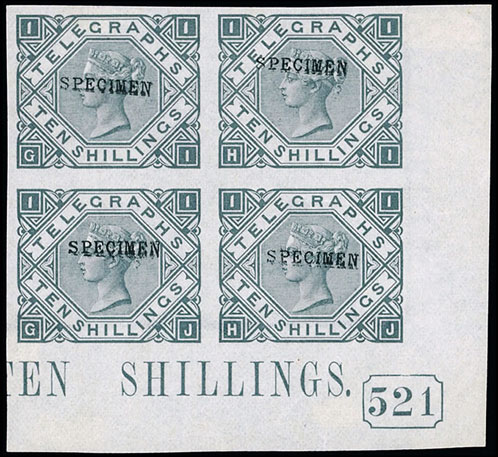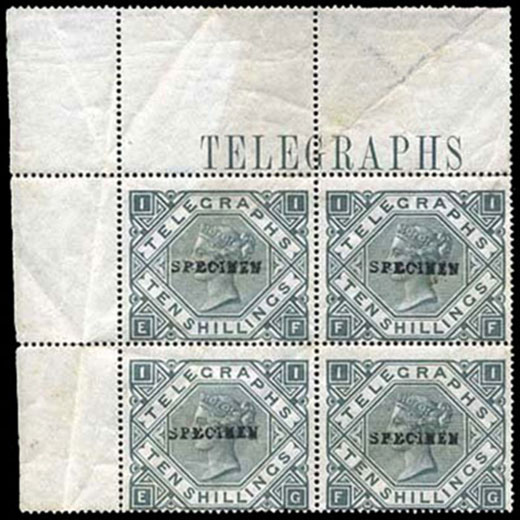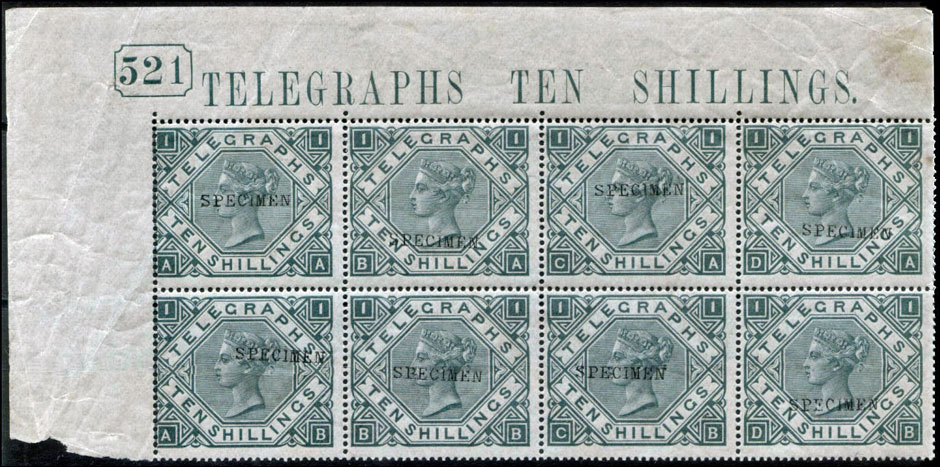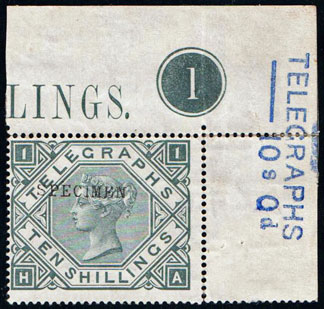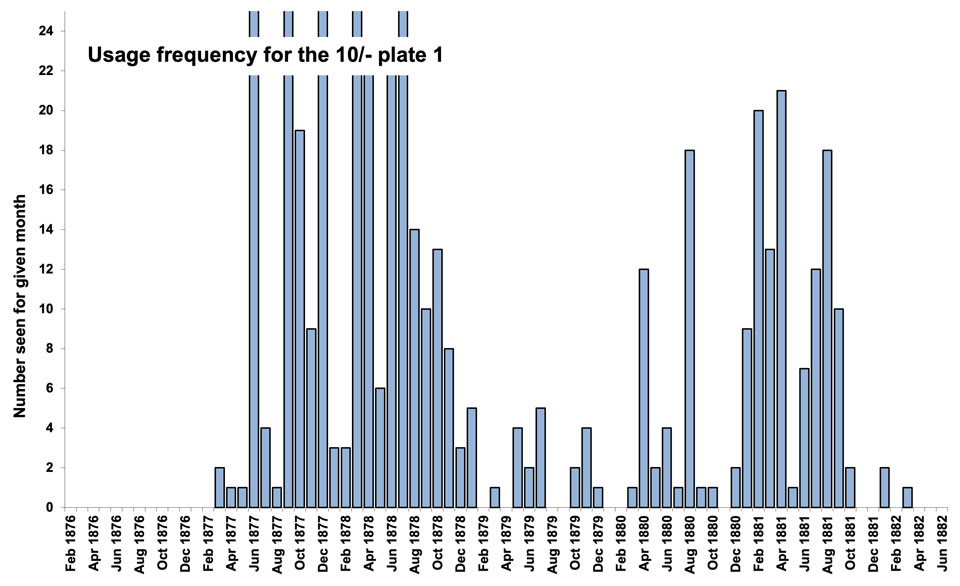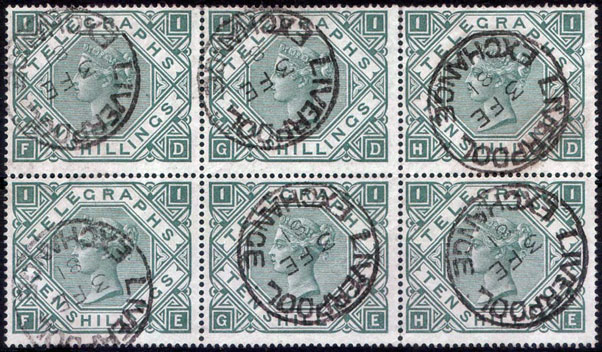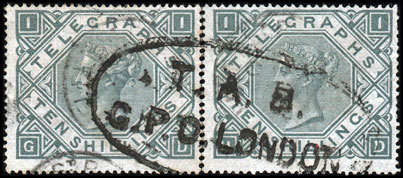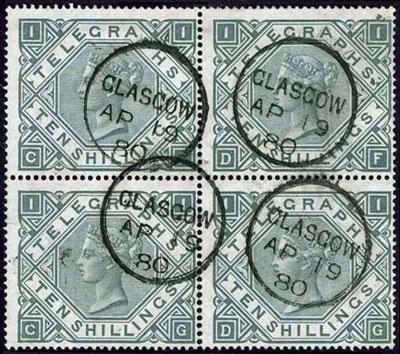1 Essays
2 Die Proofs
3 Sheet Layout
4 Plate Proofs
5 Paper
6 Colour Trials
7 Imprimaturs
8 Colour Standards
9 Specimens
10 Issued Stamps
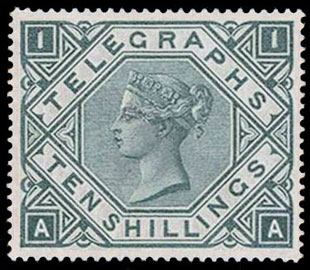
Date: 1 Mar 1877
Plates: 1
Printer: De La Rue
Watermark: Maltese Cross
Perforation: 15×15½
Soon after the first issue of telegraph stamps on 1 Feb 1876 there was a demand for more values. On 24 Mar 1876 the Postmaster General approved six new values: 4d, 6d, 3s, 10s, £1, and £5.
It had been decided that telegraph stamps of the same value as postage stamps would be printed in the same colour and on the same paper as the corresponding postage stamps. However, at the time there was no corresponding 10s postage stamp (first issued in 1878), so Maltese Cross paper was chosen to match the 5s and trials were produced in six different colours.
Only one plate was prepared and registered.
Essays
Several essays were prepared by De La Rue for the second issue, including designs lettered ‘C’ to ‘H’ and dated 21 Apr 76. Approved designs of all six values were submitted later but are undated. All of these are now in the Royal Philatelic Collection.
| H | 10s | 66 | NN | green |
| — | 10s | 66 | NN | bluish grey, approved design |
For more details on second issue essays click here.
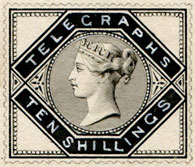
This is from a set of 12 black & white essays which are undated but believed to be circa 1880. Their purpose is not known, but they are likely not related to the issued stamps.
| — | 10s | — | — | black & white |
For more details on additional essays click here.
Die Proofs
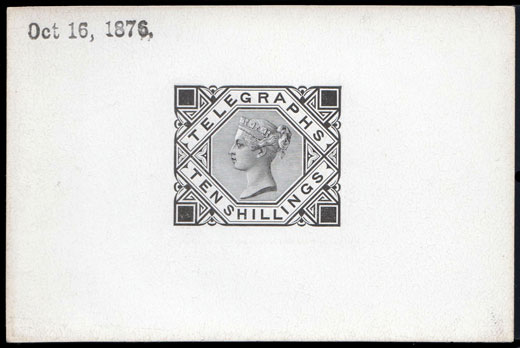
To see more 10s Die Proofs click here.
| Oct 14, 1876 | — | — | — | 1 + 1 |
| Oct 16, 1876 | — | — | — | 2 + 1 |
| Oct 17, 1876 | — | — | — | 3 + 1 |
| Oct 18, 1876 | — | — | — | 4 + 1 |
| Oct 19, 1876 | — | — | — | 4 + 1 |
| Oct 20, 1876 | — | — | — | 3 |
| Oct 20, 1876 | — | — | “BEFORE HARDENING” | 1 + 1 |
| no date | — | — | Basic Die Proof | 0 + 2 |
| no date | — | — | Cut down to stamp size | 1 |
| 1876 | — | — | — | 0 + 1 |
From the Striking Books
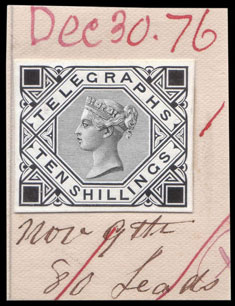
| Nov 9, 1876 | — | — | “Nov 9 / 80 Leads”, “Dec 30.76 / P” | 1 |
In a Countersunk Frame
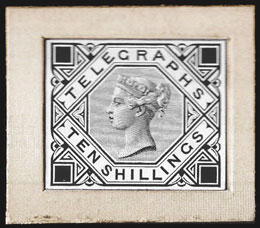
| no date | — | — | Cut down, set in a countersunk frame | 2* |
* Other values have both cream and buff frames. A buff frame may exist, but has not been seen by us.
Sheet Layout
The sheet had 80 stamps in four panes, arranged two by two. Each pane had 20 stamps in five rows of four. Above and below each pane was “TELEGRAPHS TEN SHILLINGS.”. Plate numbers were in the upper right and lower left corners, current numbers in the lower right and upper left corners. At the middle of each side was a cross and a horizontal line used as guides for perforating.
10 shillings and above could be supplied singly to postmasters, there were no Post Office sheets.
Computer generated image, click to enlarge.
Plate Proofs
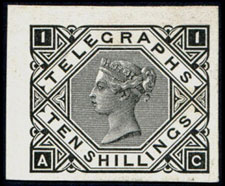
Plate proofs are known for plate 1. The reconstruction suggests there was a block of six and a single. The single DF has large margins all round suggesting it was the only one taken from that pane.
Red represents an institutionalised example.
Green a known example in private hands.
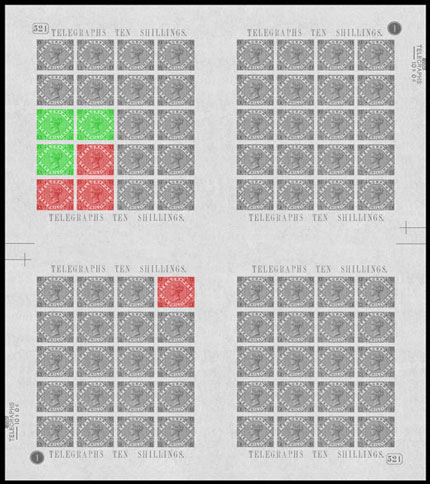
One pair is intact in the Royal Philatelic Collection: BD-BE.
DF is in the Langmead Collection, AE is in the Phillips Collection.
AD is illustrated in Wright and Creeke.
Paper
The 10s telegraph stamp predates the 10s postage stamp (1878) so there was no corresponding paper. It was decided to print it on the same Maltese Cross paper as the 5s.
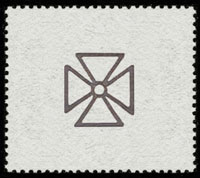
For more details on Maltese Cross paper click here.
Colour Trials
For the second issue, colour trials were taken for all six values. They were dated “15 DEC 76”. The 10s was printed in six different colours, one sheet of each, with a letter “A” through “F” written in the sheet margin next to the datestamp, below DJ-EJ. Other blocks have had letters added, presumably after they were cut from the sheet.
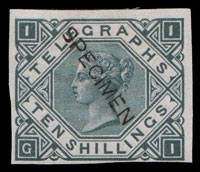
A: Grey-green
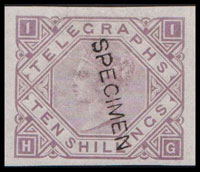
D: Dull Mauve
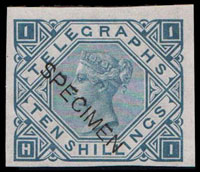
B: Slate-blue
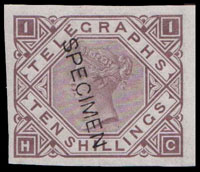
E: Brown-lilac
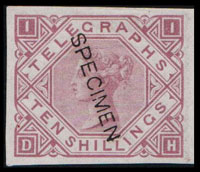
C: Dull Claret
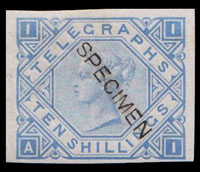
F: Pale Ultramarine
All are overprinted with Specimen Type 8 diagonal down (at various angles), except for the selected colour (A: Grey-green) which has three types of Specimen overprint all from the same sheet.
A: Grey-green (Selected Colour)

Type 8 diagonal down
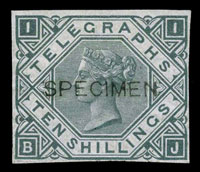
Type 8 horizontal
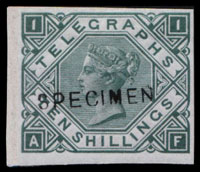
Type 11 horizontal
| Type 8: | Diag Down | Horizontal | Diag Up |
| Type 11: | Diag Down | Horizontal | Diag Up |
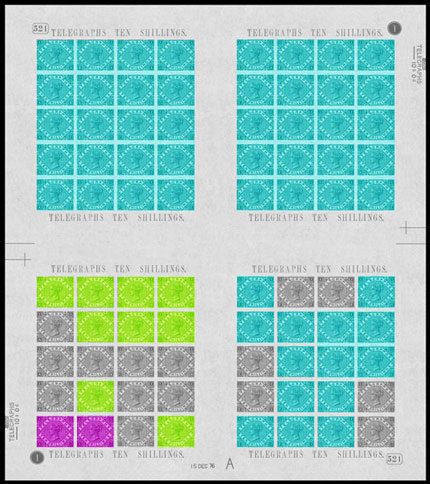
Red represents an institutionalised example.
Green a known example in private hands.
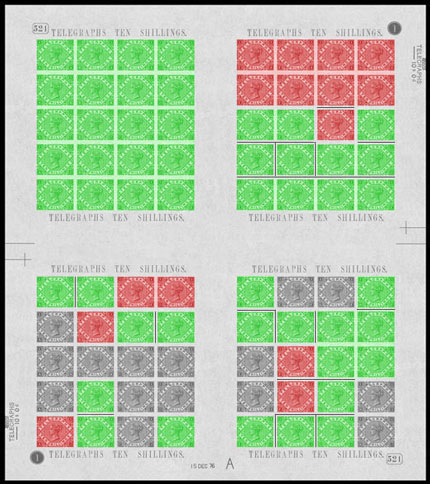
Plate number block EA-HB, pair CF-DF, and singles AJ, BG and GC are in the Langmead Collection.
FH is in the Royal Philatelic Collection, FI in the Phillips Collection.
A block of eight ED-HE has recently been split.
B: Slate-blue
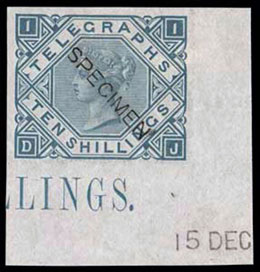
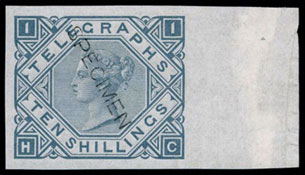
DJ shows part of the “15 DEC 76” datestamp.
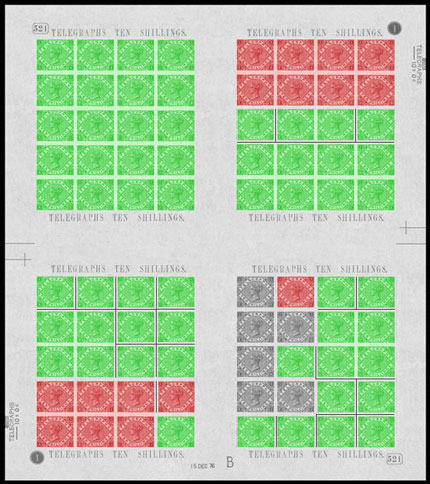
Both plate number blocks EA-HB and AI-CJ, and single DI are in the Langmead Collection.
FF is in the Royal Philatelic Collection.
C: Dull Claret
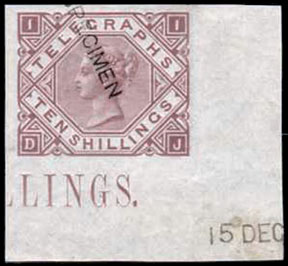
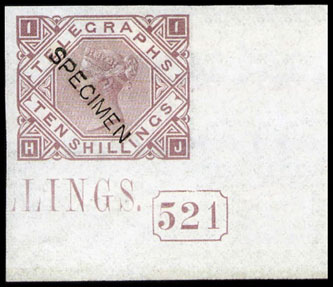
Several examples in this sheet show the Specimen overprint misplaced and overlapping two stamps.
DJ shows part of the “15 DEC 76” datestamp.
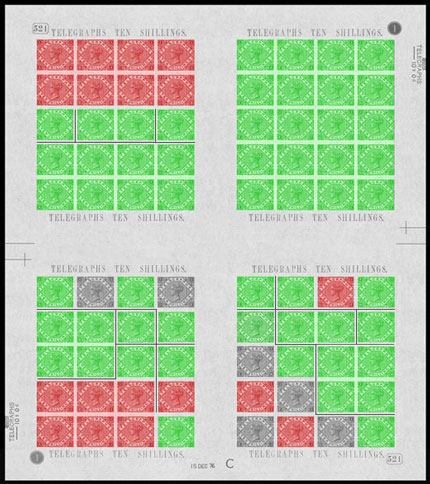
Plate number block AA-DB, current number block AI-CJ, and single FJ are in the Langmead Collection.
GF is in the Royal Philatelic Collection, DI in the Tapling Collection, EI in the Phillips Collection.
D: Dull Mauve
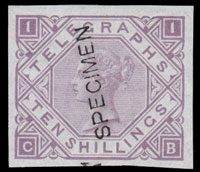
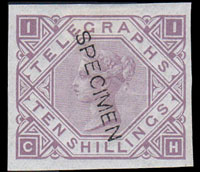
FE has a double overprint.
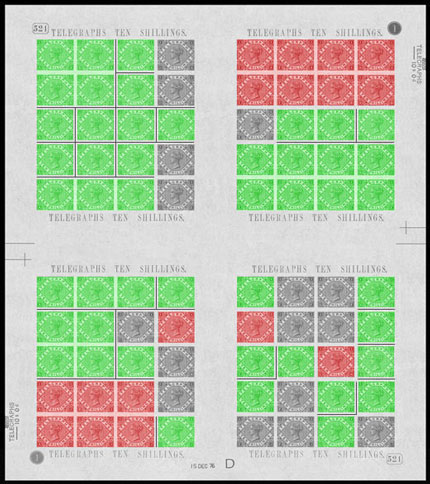
Both plate number blocks EA-HB and AI-CJ, and single GH are in the Langmead Collection.
DG is in the Royal Philatelic Collection, EG in the Phillips Collection.
E: Brown-lilac
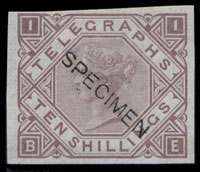

All are overprinted with Specimen Type 8 diagonal down, although more vertical on pane EA-HE.
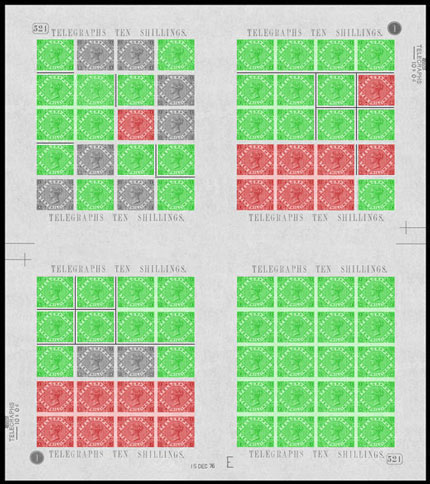
Plate number block AI-DJ, block ED-GE, and single HD are in the Langmead Collection.
HB is in the Royal Philatelic Collection, CC in the Phillips Collection.
A block of eight AF-DG has recently been split.
F: Pale Ultramarine
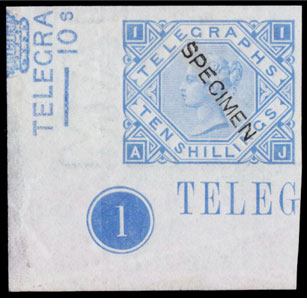

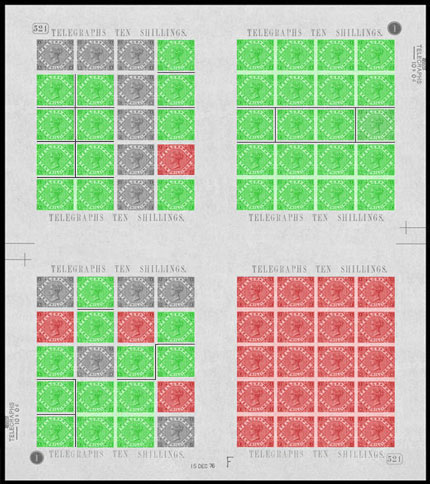
Current number pane EF-HJ and single CG are in the Langmead Collection.
AG is in the Royal Philatelic Collection, DD in the Tapling Collection, DI in the Phillips Collection.
Colour Trial Images
Click the images to enlarge.
Imprimaturs
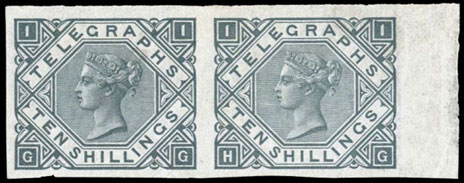
Plate 1 was registered on 17 Jan 1877.
The registration sheets for the Telegraphs have been lost. We can reconstruct them from known examples; however, the pattern that emerges for the high values is not as clear as that for the low values.
The low values generally have a column of 12 taken, plus four from the adjacent column, and a plate number example from the opposite corner. One sheet of each value has an extra column of 12 taken. The 10s almost fits this pattern if we assume some errors in Langmead and Huggins:
– AD should be DA, especially as DA appeared in several auctions.
– BG should be GB, as BG would be in the middle of a pane.
– DI was not taken, confusion between DI and DJ.
Red represents an institutionalised example.
Green a known example in private hands.
Blue is unknown but predicted by the pattern.
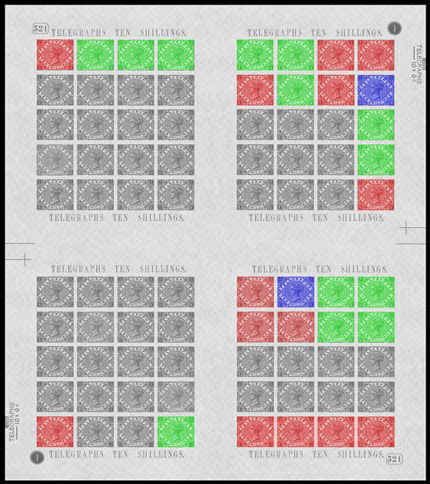
| Institutionalised/Total: | 14/29 |
| Royal Philatelic Collection: | AJ, EF-EG, HA |
| British Postal Museum: | GB, EB |
| Tapling Collection: | HE |
| Langmead Collection: | AA, EJ-HJ |
| Phillips Collection: | FG, GA |
Assumes AD->DA, BG->GB, and no DI.
A strip of four EJ-HJ, and a pair EF-EG, remain intact.
Another pair GG-HG was recently split (illustrated above).
Colour Standards
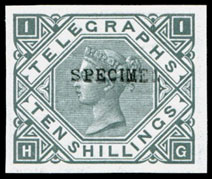
One complete sheet came on to the market in the 1930s: plate 1, imperforate, overprinted Specimen Type 9 horizontally. Singles were difficult until Marcus Samuel’s block of eight EF-HG was split.
Red represents an institutionalised example.
Green a known example in private hands.
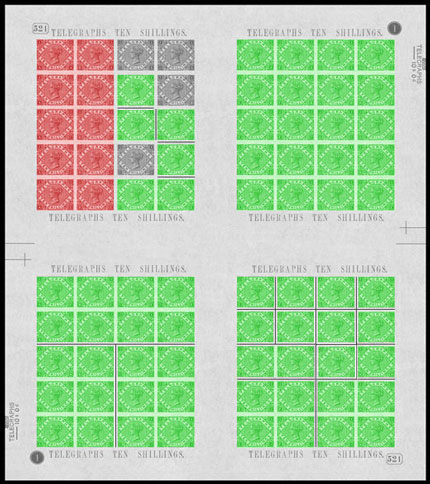
Block AA-BE is in the Langmead Collection.
Click the images to enlarge.
Specimens
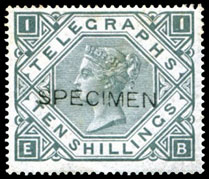
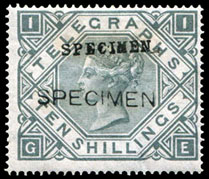
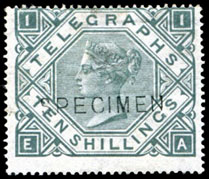
Plate 1 Type 8: scarce, from 4 panes (AA-DE, EA-HE x3), all singles.
Plate 1 Type 8 and Type 9b: rare, two singles known, GE and HD (Langmead Collection).
Plate 1 Type 11: scarce, from 3 panes (EA-HE x3), all singles.
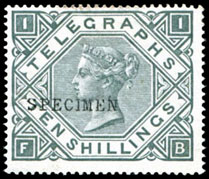
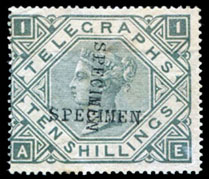
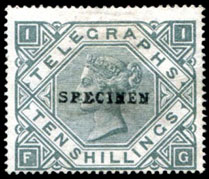
Plate 1 Type 9: common, from 6 panes (AA-DE x3, EA-HE x3), blocks of 4 (x3), 6, and 8 known.
Plate 1 Type 9: double overprint on AE.
Plate 1 Type 9b: scarce, from 3 panes (EF-HJ x3), a pair, strips of 3 and 4, blocks of 4 (x2) known.
Click the images to enlarge.
Reference to scarcity, blocks and the number of sheets or panes so treated is derived from reconstructions of known examples within our database.
Issued Stamps
Stamps were issued from one plate only.
The usage frequency graph shows that plate 1 was used across the whole period of the second issue.
Click the graph to enlarge.
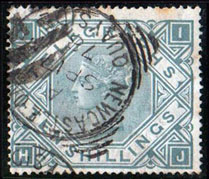
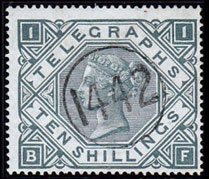
Postal, fiscal, and railway usage are rare, with one fake postal usage and only 589, 973, 1376 and 1442 “English Station” railway numerals known to us.
Issued Stamps — Plate 1
Plate 1 (current no. 521) was registered on 17 Jan 1877 and put to press on 19 Jan 1877. 6,500 sheets were printed before telegraph stamps were discontinued.
Scarcity #32 in mint telegraphs, #6 in used telegraphs.
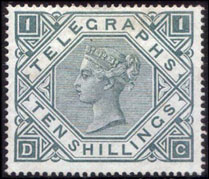
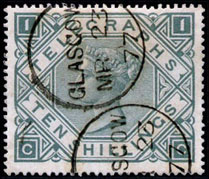
No mint multiples are known to us.
Used stamps are common. Used multiples are less common with seven pairs, a strip of 3, a block of 4, and a block of 6 in our database. The earliest known used examples are 23 Mar 1877 at Glasgow (illustrated) and at Liverpool Exchange.
Inverted watermarks probably exist but cannot be distinguished on Maltese Cross paper.
Click the images to enlarge.
The oval London TAB cancellation on the rejoined pair above was proofed on 23/24 March 1870 and sent to Mr. Green of the Telegraph Accounts Branch, Threadneedle St, London E.C.
